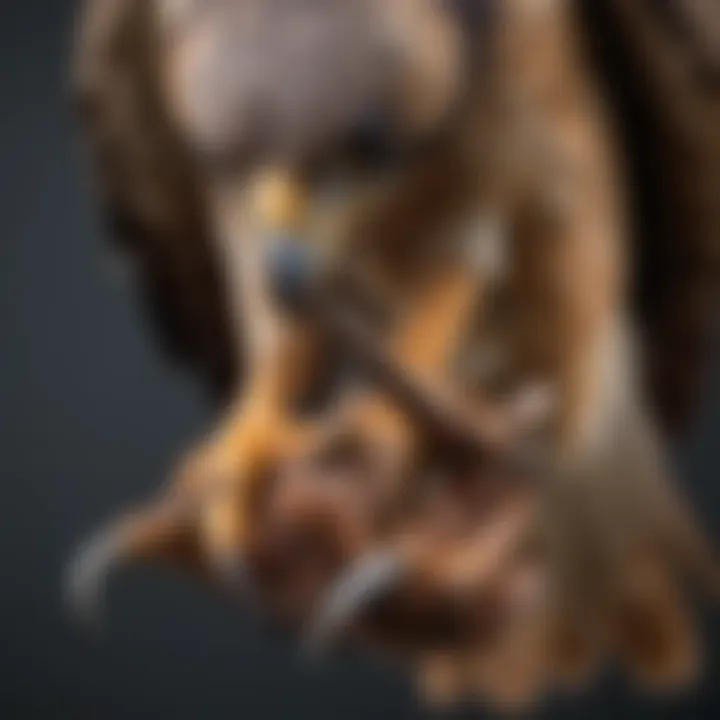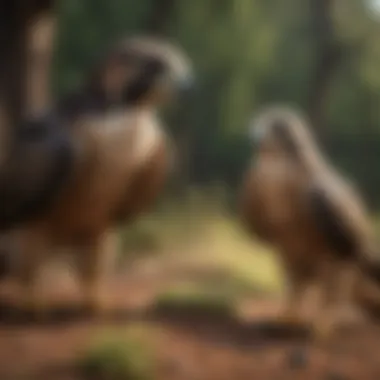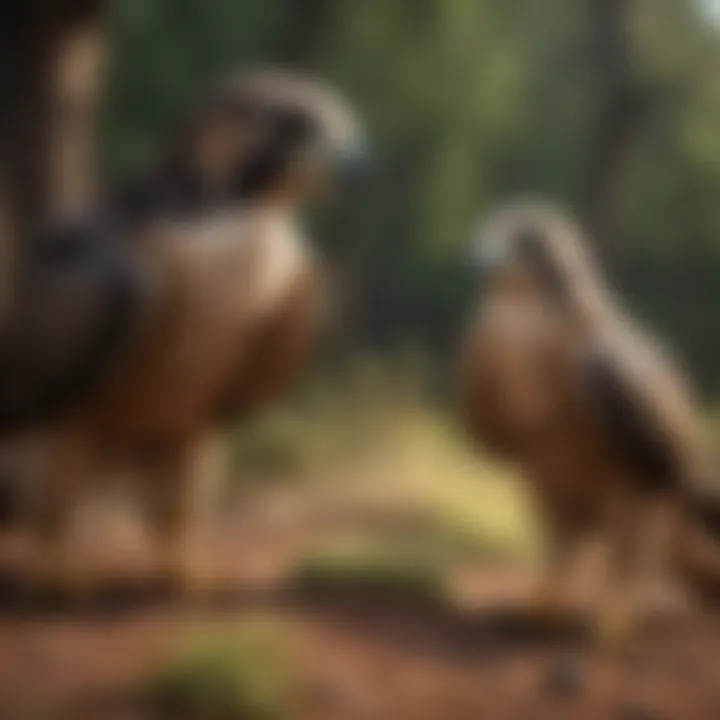Exploring Falcon Diets: Prey, Hunting, and Ecology


Nature Topic Overview
Falcons are fascinating birds of prey known for their impressive soaring abilities and keen hunting skills. Understanding their diet is crucial for appreciating their role in the ecosystem. Various species of falcons adapt to different habitats, and their diet reflects the local availability of prey. From small birds to rodents, these raptors demonstrate a wide range of feeding habits that help maintain the balance of their environments.
The diversity of falcon diets can be influenced by geographical location and habitat type. For instance, prairie falcons often hunt small mammals and birds in open grasslands, while the peregrine falcon, renowned for its rapid dives, preys primarily on other birds. This article will delve into the intricate details of falcon diets, including their hunting methods and the ecological implications of their feeding behavior.
Fun Facts and Trivia
Here are some intriguing facts about falcons that may surprise you:
- Speed: The peregrine falcon is the fastest bird, reaching speeds over 240 miles per hour when diving.
- Eyesight: Falcons have excellent vision, allowing them to spot prey from great heights.
- Diversity: There are about 40 species of falcons worldwide, each adapted to its environment.
Visual aids and quizzes can enhance your understanding of these remarkable creatures. For example, you could create a mind map outlining different falcon species and their prey types.
Wildlife Explorations
Different species of falcons exist in various habitats around the world. Below are a few notable examples:
- Peregrine Falcon: These birds are found in urban areas and coastal cliffs. Known for their strength and speed, they primarily hunt birds in flight.
- Gyrfalcon: The largest of the falcon species, found in the Arctic and sub-Arctic regions. They mainly eat birds and small mammals.
- American Kestrel: This small falcon is often seen in open fields and grasslands, feeding on insects and small rodents.
Each falcon species has adapted its hunting techniques based on the environment and available seafood. A fun activity may involve drawing a food web that includes various animals in falcon habitats.
Environmental Awareness
Conservation plays a significant role in the survival of falcons and their prey. Falcon populations can be affected by habitat destruction and climate change. Protecting their natural habitats is essential for maintaining biodiversity and ensuring these birds can thrive.
Children can contribute to conservation efforts by:
- Learning about local ecosystems and respecting wildlife.
- Participating in local tree planting events to help restore habitats.
- Reporting sightings of falcons to local wildlife organizations.
Encouraging a connection with nature and fostering an understanding of ecological systems will help promote stewardship among young audiences.
DIY Nature Activities
Engaging kids in hands-on activities can reinforce learning about falcons:
- Bird Watching Journal: Encourage kids to observe local birds and note their findings. Include sections for drawings and descriptions of the behavior they witness.
- Nature Collage: Collect leaves, feathers, and small branches to create a nature collage that represents falcon habitats.
- Outdoor Treasure Hunt: Organize a scavenger hunt that includes items related to falcon diets, like small stones, branches, and pictures of prey species.
By incorporating these activities, children can enjoy learning about falcons while developing a deeper appreciation for nature.
Intro to Falcon Dietary Habits
Understanding the dietary habits of falcons is essential for appreciating their role in ecosystems. Falcons are remarkable birds of prey, and their feeding behaviors reflect their adaptations and ecological niches. These habits vary significantly among species and are influenced by factors like habitat, prey availability, and seasonal changes.
Falcons primarily regulate their populations through predation, but their diet extends beyond merely surviving. It showcases their interactions with other organisms and sends ripples through the entire food web. Their unique feeding strategies, such as high-speed hunting and target selection, underline their importance as both predators and biodiversity indicators.
Many kids, parents, and teachers find it intriguing to learn about what these birds eat. This understanding not only fosters a respect for wildlife but also highlights the importance of preserving their habitats. When we look at falcons and their diets, we see a window into the broader environmental health.
Additionally, it is vital to consider how falcon diets can shift in response to changes in their environment, such as urban expansion or climate change. This topic invites curiosity and discussion across various ages, making it a significant aspect of wildlife education.
"Falcons are more than predators; they are vital players in maintaining ecological balance."
Overall, exploring falcon dietary habits allows us to appreciate their uniqueness and the intricacies of nature. As we proceed through this article, we will delve deeper into various aspects of their diets, hunting methods, nutritional needs, and the impact of their prey choices on ecosystems.
Types of Falcons
Understanding the types of falcons is crucial for comprehending their diets and ecological roles. There are various species of falcons, each with unique dietary preferences and adaptations. By examining the different types of falcons, we can appreciate the diversity present in the falcon family and how these differences influence their feeding behavior.
Common Falcon Species
Peregrine Falcon
The Peregrine Falcon is well-known for being the fastest bird in the world. Its incredible speed allows it to dive from great heights, catching prey in mid-air. This characteristic makes the Peregrine Falcon a fascinating subject in the study of falcon diets. Their primary diet consists of small to medium-sized birds, utilizing their agility and speed as key advantages in hunting. However, Peregrine Falcons are also affected by environmental changes, which can limit their prey availability.
American Kestrel
The American Kestrel is the smallest falcon in North America. It primarily feeds on insects and small mammals, often hunting from a perch to spot its prey. Its size allows it to be a versatile hunter, adapting to a wide range of habitats. The American Kestrel is significant for understanding falcon diets because it shows how size and habitat impact dietary choices.
Merlin
The Merlin is another small falcon that is known for its fierce nature. It primarily hunts small birds, often chasing them in aerial pursuits. This adaptive hunting technique allows it to thrive in various environments. The value of the Merlin in studying falcon diets lies in its unique hunting strategies and prey preferences compared to other species.


Unique Characteristics of Falcon Species
Size variations
Falcon species exhibit considerable size variations, which influence their dietary habits. Larger falcons, such as the Peregrine, can pursue larger prey, whereas smaller species tend to target insects and small birds. This size difference highlights the adaptability of falcons to various ecological niches.
Habitat preferences
Different falcon species have distinct habitat preferences that affect their access to food. For instance, some prefer open areas, while others are more successful in urban environments. Understanding these preferences helps illustrate the relationship between habitat and diet in falcons.
Geographical distribution
Geographical distribution also plays a key role in the diet of falcons. Certain species are more prevalent in specific regions, affecting their available prey. Studying these distribution patterns can reveal insights into how falcons adapt their diets based on local ecology.
What Do Falcons Eat?
Primary Prey Items
Small birds
Falcons commonly hunt small birds, which are integral to their diet. These avian creatures serve as an abundant source of protein and energy. The swift flight and agility of small birds make them both challenging and rewarding targets for falcons. They can react quickly, and their erratic movements encourage falcons to refine their hunting skills.
Small birds enable falcons to maximize their hunting efficiency, as they tend to congregate in flocks, providing multiple opportunities for successful catches. However, hunting these birds requires precision and speed, and falcons have evolved keen eyesight to spot them from great distances.
Mammals
Mammals also contribute significantly to the diet of certain falcon species. This group includes small rodents like mice or voles, which are often easier to catch due to their ground-dwelling habits. The key characteristic of mammals as prey for falcons is their nutritional value, offering high levels of protein necessary for a falcon's energy needs.
The inclusion of mammals in their diet can offer a more substantial meal compared to small birds. However, hunting mammals may pose a greater challenge because they are often more cautious and can evade predators effectively when they sense danger. This behavior can limit the falcon's success rate.
Insects
Insects represent another vital component of falcon diets, particularly for those that hunt at certain times of the year. These creatures can be abundant, especially during warmer months when many insects are active. Utilizing insects as prey benefits falcons by providing easily accessible meals that require less energy to catch.
The unique feature of insects is their high reproduction rate, which often leads to fluctuations in availability. While insects may not offer as much protein as birds or mammals, they help fill in the dietary gaps when other prey is scarce.
Variations in Diet by Species
Specialized feeders
Certain falcons are known as specialized feeders because they target specific prey in their diets. An example is the Peregrine Falcon, which primarily hunts birds in flight. This specialization allows them to develop unique hunting strategies suited for capturing airborne prey.
The benefit of being a specialized feeder is the ability to master techniques effective against specific prey, boosting hunting efficiency. However, this can also be a disadvantage. If their primary prey becomes scarce, their hunting may suffer more than that of generalist feeders.
Generalist feeders
In contrast, some falcons are generalist feeders, adapting their diets based on availability. For instance, American Kestrels demonstrate this flexibility by eating anything from small birds and mammals to insects. This adaptability is advantageous as it allows them to exploit a broader range of food sources.
Their ability to thrive on variations within their diet enables generalist feeders to survive in diverse environments. However, this flexibility might lead to less optimal hunting techniques compared to specialized feeders focused solely on one prey type.
Hunting Techniques of Falcons
Understanding the hunting techniques of falcons is critical to comprehending their diet. These techniques demonstrate how these birds of prey feed effectively in various environments. The hunting methods can differ significantly among falcon species, but they often focus on maximizing efficiency and success. Learning about these methods sheds light on the adaptations of falcons to their ecological niches and the balance they help maintain within their respective ecosystems.
Aerial Hunting Strategies
Stooping
Stooping is an aerial diving technique used mainly by falcons, especially the Peregrine falcon. This method involves a rapid descent from heights, where they gain speed to catch unsuspecting prey, primarily birds. The key characteristic of stooping is the incredible velocity achieved during the dive. A falcon can reach speeds of over 240 miles per hour when stooping, making it one of the fastest creatures on Earth.
This technique is highly effective for several reasons. First, it allows the falcon to use gravity to enhance its speed, resulting in a forceful impact when it strikes its target. Second, the element of surprise plays a crucial role, as the prey may not see the falcon approaching from above.
However, stooping does have its downsides. The high-speed descent can be physically demanding for the falcon, and if the attack is unsuccessful, they may expend significant energy with little reward. Nevertheless, stooping remains a popular choice for many falcon species due to its effectiveness.
Surprise Attacks
Surprise attacks are another hunting technique used by falcons. In this method, falcons use cover and stealth to approach their prey. They may wait patiently, concealed within trees or shrubs, and then launch a sudden assault when the opportunity arises. The key characteristic of surprise attacks is deception. By remaining hidden until the last possible moment, falcons increase their chances of catching their prey off guard.
This technique is beneficial for several reasons. First, it allows falcons to capture smaller or more agile species that might escape during high-speed pursuits. Second, the reduced energy expenditure compared to full aerial dives makes surprise attacks a more sustainable option, especially during long hunts.
However, surprise attacks also come with challenges. Success heavily relies on the falcon’s ability to remain undetected, which can be difficult in open environments. Still, this technique's adaptability makes it an important aspect of a falcon's hunting repertoire.


Ground-Based Hunting Tactics
Perching
Perching is a ground-based method that involves falcons sitting on high vantage points to survey their surroundings for potential prey. This technique is crucial for spotting movements from a distance. A key characteristic of perching is its passive nature; rather than actively pursuing prey, the falcon patiently waits for an opportunity to strike.
The benefit of perching lies in its energy efficiency. By observing the environment from a stable position, falcons conserve energy while still maintaining awareness of nearby activities. This technique is particularly effective in open fields or near water bodies, where prey is easily visible.
However, perching has limitations. If the hunting grounds are sparse, it may lead to prolonged periods without successful hunting. Yet, it's essential as it forms part of their overall hunting strategy, marrying patience with the chance to capitalize on fleeting opportunities.
Chasing
Chasing involves pursuing prey that has already been detected. This tactic becomes essential once the falcon has spotted a target, such as a small mammal or bird. The key characteristic of chasing is its dynamic nature. It requires agility and endurance, as falcons must quickly adapt to their prey's erratic movements.
Chasing is beneficial due to the direct engagement with active prey. If a falcon is skilled at rapidly adjusting flight paths, it can efficiently apprehend evasive species. Moreover, this technique can be especially advantageous in areas where prey is abundant.
However, chasing can be energy-intensive, and a falcon may end up tiring quickly, especially if the target is adept at escaping. Therefore, falcons often incorporate this tactic with the other hunting strategies mentioned to optimize their feeding efficiency.
Overall, the diversity in hunting techniques highlights the adaptability of falcons. Each method serves a distinct purpose, showcasing their evolution as formidable predators.
Dietary Needs and Adaptations of Falcons
Falcons are remarkable birds with specific dietary needs that allow them to thrive in diverse environments. Understanding these needs is essential as it helps in conserving their populations and habitats. Their diet plays a crucial role in their life cycle, impacting their hunting behavior, reproduction, and overall health. Such knowledge sheds light on how falcons adapt to varying conditions and challenges in their ecosystems.
Nutritional Requirements
Protein intake
Protein is a fundamental element in the diet of falcons. This macronutrient is essential for building and repairing tissues, which is vital for maintenance and growth. Falcon species typically rely on protein-rich prey like small birds and mammals. The high protein content supports their energy-intensive lifestyle, including nesting and raising young. An adequate intake of protein enhances their physical abilities, crucial during the hunting season. Evidence suggests that falcons show a marked preference for prey that provides optimal protein levels, which supports their strenuous activities.
Energy demands
Energy demands in falcons are significant due to their active lifestyle. They require a diet that not only replenishes energy but also sustains their high metabolic rate. Falcons engage in rapid and intense flight, which burns energy quickly. Consequently, their diet must include foods that provide quick access to energy. Small birds and insects are often part of their diet, as these prey items yield the necessary calories. Proper energy intake is vital for sustaining endurance during long hunting trips and for effective mating displays. When falcons do not meet their energy needs, it can affect their health and ability to reproduce.
Physiological Adaptations
Beak structure
The beak structure of falcons is finely adapted to their dietary needs. Falcons possess hooked beaks, which are essential for tearing flesh. This adaptation allows them to consume their prey efficiently. The design of the beak is not just about eating; it also contributes to their overall hunting success. The sharp edges can quickly slice through tough feathers and skin, enabling faster feeding. This feature is a distinct advantage for young birds that need rapid growth to survive in the wild.
Talons
Talons are another critical adaptation that plays a significant role in how falcons secure their prey. These sharp claws are designed for gripping and killing. In hunting, falcons utilize their talons to catch and hold their prey securely. This unique feature also prevents escape, enhancing their hunting effectiveness. Proper development and strength of their talons are essential for young falcons as they learn to hunt. The powerful grip of their talons is crucial not only for catching prey but also for balancing while landing and taking off.
Key to Falcon Success: An optimal diet supported by unique adaptations like beak structure and talons enables falcons to excel as skilled hunters in their environments.
Impact of Habitat on Falcon Diet
The diet of falcons is greatly influenced by their habitat. Different environments offer various types of prey, which impacts a falcon's feeding behavior. Understanding the relationship between habitat and diet is crucial for conservation efforts. It helps to identify how changes in the environment affect food availability for these birds. Additionally, habitat preservation becomes important to ensure that falcons can thrive.
Urban versus Rural Diet
Foraging in cities
Falcons often adapt exceptionally well to urban environments. In city landscapes, they find plentiful food sources such as pigeons and sparrows. This adaptation allows them to thrive in areas where traditional prey might be harder to find.
When hunting in cities, falcons can utilize tall buildings as vantage points. This gives them a height advantage, allowing them to spot potential prey more effectively. Another benefit is the abundance of nesting sites, which are provided by structures like bridges and skyscrapers. However, urban environments can pose risks, such as collisions with windows and vehicles.
Natural environments
In contrast, falcons in natural environments typically have a more diverse diet. They hunt various small mammals, insects, and birds. The richness of these ecosystems provides a balance of prey that may not be available in cities. Natural habitats also allow falcons to use their traditional hunting techniques, showcasing their agility and speed.
The natural environment’s unique feature includes its seasonal fluctuations, which can affect prey availability. While rural areas usually have less immediate human impact, they can be affected by habitat destruction and changes in land use. This can significantly impact falcon populations and their dietary habits.
Seasonal Variations in Diet
Winter foraging habits
During winter, falcons' diets often change due to the scarcity of prey. Many birds migrate south, leaving falcons to hunt different prey species. They may rely more on mammals such as mice and voles. Seasonal shifts in weather can also play a role in hunting and foraging strategies. This aspect of winter foraging is critical to understanding how falcons adjust to changing availability of food.
Breeding season feeding


In the breeding season, falcons increase their food intake. The need for extra energy is vital for both parents, who must feed their young. During this time, they often hunt more efficiently. The main characteristic of this period is high prey capture rates, which ensures healthy growth for the fledglings. The success in feeding during breeding times impacts the overall survival of the species.
Understanding the dietary habits of falcons in these various contexts offers important insights into their adaptive strategies. This knowledge is beneficial for developing conservation plans that support their populations in changing environments.
Falcon Diet and Ecosystem Dynamics
Role of Falcons in Food Webs
Predator-prey relationships
Falcons play an important role in predator-prey relationships. They help regulate populations of smaller birds and mammals. This regulation keeps the ecosystem balanced. If falcon populations decline, there could be overpopulation of their prey species. This can lead to negative effects, such as overgrazing or the depletion of resources.
Key characteristics of these relationships include the hunting behavior of falcons. This hunting ensures the survival of both prey and predator. The unique feature of predator-prey dynamics is the natural selection that occurs. Only the fittest individuals tend to survive, promoting healthy populations.
"Predator-prey interactions are vital. They drive evolution and maintain ecological balance."
Biodiversity indicators
Falcons serve as indicators of biodiversity in their habitats. A diverse range of prey leads to a healthier falcon population, indicating a robust ecosystem. Monitoring falcon diets can reveal important information about environmental health. If falcons struggle to find their prey, this may suggest ecological problems.
Their role as biodiversity indicators emphasizes the importance of preserving the various prey species they feed on. The unique feature of this relationship is its capacity to reflect broader ecological conditions. As such, tracking falcon populations can aid conservation efforts by highlighting urgent ecological issues.
Conservation Implications
Prey species conservation
Conservation of prey species is essential for maintaining falcon populations. If prey species face decline, falcons will also suffer. This connection highlights the need for focused conservation efforts. Protecting specific prey species can lead to the restoration of falcon populations. It creates a sustainable environment for all species involved.
One key characteristic is the interconnectedness of food webs. Healthy prey populations ensure that falcons can thrive. This is especially important in regions where falcon numbers are already low.
Habitat protection
Habitat protection plays a critical role in the well-being of falcons and their prey. By preserving natural habitats, we can secure a stable food source for falcons. Specific characteristics of habitat protection include the regulation of land use and development.
A unique feature of habitat protection is how it supports entire ecosystems. Once habitats are secure, not only falcons benefit; many species in these environments thrive. The advantages of maintaining habitats extend to all flora and fauna within these ecosystems.
Feeding Falcons in Captivity
Feeding falcons in captivity is critical for their health and well-being. Understanding their dietary needs helps promote optimal growth and behavior. In captivity, falcons often face different challenges compared to their wild counterparts. Therefore, it is vital to provide a diet that mimics their natural feeding habits. Various feeding strategies can ensure that captive falcons receive the necessary nutrients.
Diet Composition in Captivity
Captive falcons’ diets can be divided into two main categories: commercial diets and whole prey feeding.
Commercial diets
Commercial diets for falcons are designed to meet specific nutritional needs. These diets typically consist of pellets or formulations that include meat, vitamins, and minerals. One of the key characteristics of commercial diets is convenience. They are easy to store and measure. They also minimize the risk of contamination compared to natural prey. However, some argue that these diets may not provide the full spectrum of nutrients found in whole prey. This can lead to potential deficiencies if not carefully managed.
Whole prey feeding
Whole prey feeding involves giving captive falcons whole animals. This method is believed to be close to their natural diet. A key characteristic here is that it includes feathers, bones, and organs. These components offer natural enrichment and contribute to better health. However, whole prey feeding can also come with challenges. It requires proper storage and handling to prevent spoilage and can be more expensive. Careful monitoring is essential to ensure that all aspects of nutrition are covered.
Challenges of Captive Feeding
Fulfilling the specific dietary requirements of captive falcons comes with its own challenges. Two significant areas of concern are nutritional balance and behavioral health.
Nutritional balance
Maintaining nutritional balance is essential for captive falcons. A well-balanced diet supports their energy levels and overall health. The key characteristic of achieving this balance lies in understanding their unique needs. This is especially important for different species, as they may have various requirements. If the nutritional needs are not met, it can lead to health issues such as obesity or deficiencies. Meeting these challenges is crucial for keeping captive falcons thriving.
Behavioral health
Behavioral health is another important aspect of feeding falcons in captivity. Captive birds may experience stress if their environment does not fulfill their natural instincts. Providing a diet that encourages natural foraging behavior is essential. This helps to keep falcons mentally stimulated. A proper diet can foster natural behaviors that are critical for their well-being. Proper management can reduce the risks of abnormal behaviors and promote a healthier life in captivity.
"A proper diet can foster natural behaviors that are critical for their well-being."
Educating caregivers about these feeding strategies will significantly benefit the falcons. By understanding the nuances of falcon diets, caretakers can ensure that these magnificent birds thrive even outside their natural habitats.
Closure
In this article, we have delved into the fascinating world of falcon diets, shedding light on various aspects that contribute to their feeding habits and the greater implications for ecosystems. Understanding the dietary patterns of falcons is crucial for several reasons.
Ecological Balance: One of the key elements we explored is how falcons function within the food webs. They are apex predators, influencing the populations of their prey species, which in turn affects the biodiversity in their habitats. By keeping the numbers of smaller birds and mammals in check, falcons help maintain a balance in the ecosystem.
Conservation Efforts: As we discussed, the success of falcon populations often reflects the health of the environment. Protecting their habitats and ensuring the availability of their prey species is vital. This understanding shapes conservation strategies, highlighting the need for habitat conservation which can lead to improved biodiversity overall.
Captive Care: Feeding falcons in captivity presents unique challenges that we noted. Knowledge of their natural diets allows zookeepers and conservationists to provide more suitable diets for these birds. This will ensure they maintain both nutritional balance and behavioral health in a captive setting.
In summary, the various themes discussed in this article collectively underscore the importance of falcons beyond their hunting majesty. As they play a significant role in sustaining ecosystems and guiding conservation efforts, continued study and awareness of their feeding habits are essential. Understanding these dynamics informs our efforts toward preserving the intricate balance of nature, emphasizing the remarkable adaptations and needs of these incredible raptors.







